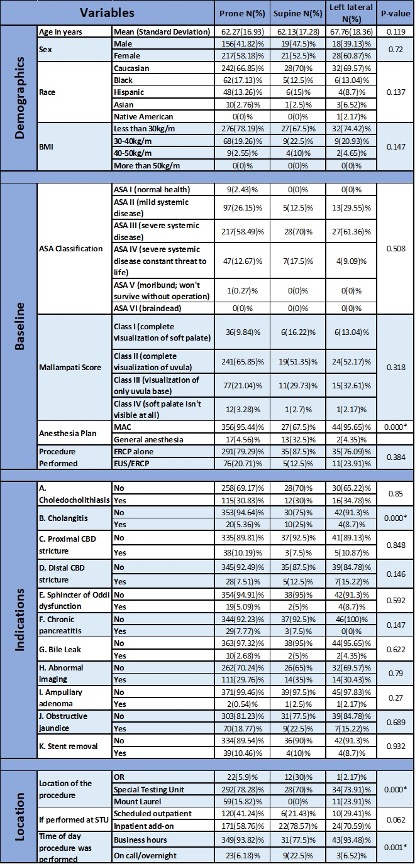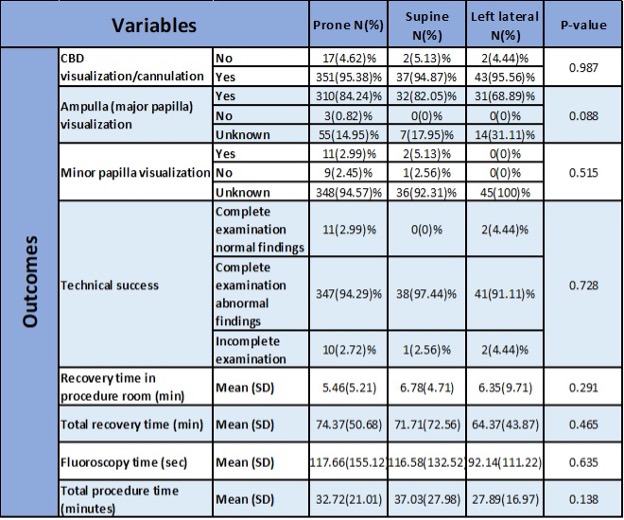Tuesday Poster Session
Category: Interventional Endoscopy
P5650 - Impact of Patient Positioning on Endoscopic Retrograde Cholangiopancreatography (ERCP) Outcomes: A Comparative Analysis of Supine, Prone, and Left Lateral Positions
Tuesday, October 28, 2025
10:30 AM - 4:00 PM PDT
Location: Exhibit Hall

Fariha Hasan, MD
Cooper University Hospital
Camden, NJ
Presenting Author(s)
Fariha Hasan, MD1, Daniel Guirguis, MD, MS2, Pooja Patel, BA3, Preksha Patel, BS3, Samuel Roy, BS4, Nicholas Talabiska, DO1, Adib Chaaya, MD1, Rachel Frank, MD5
1Cooper University Hospital, Camden, NJ; 2St. Luke's University Hospital, Hatfield, PA; 3Cooper Medical School of Rowan University, Marlton, NJ; 4Cooper Medical School of Rowan University, Camden, NJ; 5Cooper University Hospital, Philadelphia, PA
Introduction: Endoscopic retrograde cholangiopancreatography (ERCP) typically uses the prone position to reduce
aspiration risk and improve biliary imaging. The left lateral decubitus position aligns the esophagus, stomach, and duodenum, enhancing stability and minimizing abdominal compression, making it a viable alternative. The supine position offers benefits for anesthesia access and patients with obesity or wounds, but complicates endoscope alignment. While data exists on supine versus prone positioning, research comparing all three is limited. This study compares ERCP outcomes in the prone, left lateral, and supine positions to determine the optimal approach for achieving success and safety.
Methods: A retrospective review was conducted for adult patients (18 years and older) who underwent ERCP at a tertiary care hospital. Patients were categorized into three groups based on their positioning during the procedure: supine, prone, and left lateral. The primary outcome was the visualization and cannulation of the common bile duct (CBD), as well as the technical success of the procedure. Secondary outcomes included visualization of the major and minor papillae, as well as the incidence of post-ERCP pancreatitis.
Results: Of the 459 patients, 373 (81.3%) were prone, 40 (8.7%) were supine, and 46 (10%) were left lateral (Table 1). Patient demographics and medical history were similar across groups. Significant differences were observed in the procedure location (p< 0.05) and time of day (p = 0.001). Emergent surgery was more frequent in the supine position (2.5%) compared to left lateral (2.2%) and prone (0%) (p=0.012); other complication rates were similar across groups. There were no statistically significant differences between CBD cannulation, ampulla visualization, technical success of the procedure, total recovery time, fluoroscopy time, and total procedure time among the three groups (p >0.05). Details of outcomes are given in Table 2.
Discussion: ERCP performed in prone, left lateral, and supine positions yielded comparable rates of CBD cannulation, ampulla visualization, and overall technical success. While the supine position was associated with a higher rate of emergent surgery, no significant differences were observed in other procedural or recovery metrics. These findings suggest that alternative positions, particularly left lateral, may offer safe and effective options when prone positioning is not feasible, supporting individualized patient-centered positioning strategies in ERCP.

Figure: Table1. Summary of patient demographics, clinical characteristics, and procedural details.

Figure: Table 2. Procedural outcomes and intraoperative variables.
Disclosures:
Fariha Hasan indicated no relevant financial relationships.
Daniel Guirguis indicated no relevant financial relationships.
Pooja Patel indicated no relevant financial relationships.
Preksha Patel indicated no relevant financial relationships.
Samuel Roy indicated no relevant financial relationships.
Nicholas Talabiska indicated no relevant financial relationships.
Adib Chaaya indicated no relevant financial relationships.
Rachel Frank indicated no relevant financial relationships.
Fariha Hasan, MD1, Daniel Guirguis, MD, MS2, Pooja Patel, BA3, Preksha Patel, BS3, Samuel Roy, BS4, Nicholas Talabiska, DO1, Adib Chaaya, MD1, Rachel Frank, MD5. P5650 - Impact of Patient Positioning on Endoscopic Retrograde Cholangiopancreatography (ERCP) Outcomes: A Comparative Analysis of Supine, Prone, and Left Lateral Positions, ACG 2025 Annual Scientific Meeting Abstracts. Phoenix, AZ: American College of Gastroenterology.
1Cooper University Hospital, Camden, NJ; 2St. Luke's University Hospital, Hatfield, PA; 3Cooper Medical School of Rowan University, Marlton, NJ; 4Cooper Medical School of Rowan University, Camden, NJ; 5Cooper University Hospital, Philadelphia, PA
Introduction: Endoscopic retrograde cholangiopancreatography (ERCP) typically uses the prone position to reduce
aspiration risk and improve biliary imaging. The left lateral decubitus position aligns the esophagus, stomach, and duodenum, enhancing stability and minimizing abdominal compression, making it a viable alternative. The supine position offers benefits for anesthesia access and patients with obesity or wounds, but complicates endoscope alignment. While data exists on supine versus prone positioning, research comparing all three is limited. This study compares ERCP outcomes in the prone, left lateral, and supine positions to determine the optimal approach for achieving success and safety.
Methods: A retrospective review was conducted for adult patients (18 years and older) who underwent ERCP at a tertiary care hospital. Patients were categorized into three groups based on their positioning during the procedure: supine, prone, and left lateral. The primary outcome was the visualization and cannulation of the common bile duct (CBD), as well as the technical success of the procedure. Secondary outcomes included visualization of the major and minor papillae, as well as the incidence of post-ERCP pancreatitis.
Results: Of the 459 patients, 373 (81.3%) were prone, 40 (8.7%) were supine, and 46 (10%) were left lateral (Table 1). Patient demographics and medical history were similar across groups. Significant differences were observed in the procedure location (p< 0.05) and time of day (p = 0.001). Emergent surgery was more frequent in the supine position (2.5%) compared to left lateral (2.2%) and prone (0%) (p=0.012); other complication rates were similar across groups. There were no statistically significant differences between CBD cannulation, ampulla visualization, technical success of the procedure, total recovery time, fluoroscopy time, and total procedure time among the three groups (p >0.05). Details of outcomes are given in Table 2.
Discussion: ERCP performed in prone, left lateral, and supine positions yielded comparable rates of CBD cannulation, ampulla visualization, and overall technical success. While the supine position was associated with a higher rate of emergent surgery, no significant differences were observed in other procedural or recovery metrics. These findings suggest that alternative positions, particularly left lateral, may offer safe and effective options when prone positioning is not feasible, supporting individualized patient-centered positioning strategies in ERCP.

Figure: Table1. Summary of patient demographics, clinical characteristics, and procedural details.

Figure: Table 2. Procedural outcomes and intraoperative variables.
Disclosures:
Fariha Hasan indicated no relevant financial relationships.
Daniel Guirguis indicated no relevant financial relationships.
Pooja Patel indicated no relevant financial relationships.
Preksha Patel indicated no relevant financial relationships.
Samuel Roy indicated no relevant financial relationships.
Nicholas Talabiska indicated no relevant financial relationships.
Adib Chaaya indicated no relevant financial relationships.
Rachel Frank indicated no relevant financial relationships.
Fariha Hasan, MD1, Daniel Guirguis, MD, MS2, Pooja Patel, BA3, Preksha Patel, BS3, Samuel Roy, BS4, Nicholas Talabiska, DO1, Adib Chaaya, MD1, Rachel Frank, MD5. P5650 - Impact of Patient Positioning on Endoscopic Retrograde Cholangiopancreatography (ERCP) Outcomes: A Comparative Analysis of Supine, Prone, and Left Lateral Positions, ACG 2025 Annual Scientific Meeting Abstracts. Phoenix, AZ: American College of Gastroenterology.
